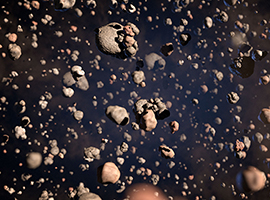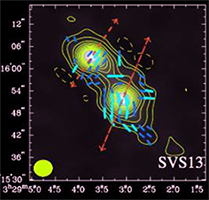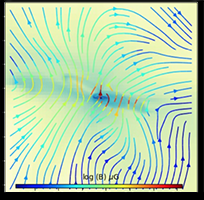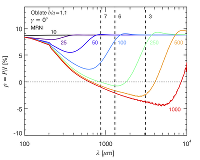Workpackages
-

WPI : Tracing protostellar envelope properties: kinematics, dust grains and ionization rates
In this work-package, we will obtain and analyze observations characterizing protostellar envelopes to better understand their dust properties, temperature and density distributions, as well as their kinematics and the key ingredients necessary to constrain the coupling of magnetic fields to the gas (ionization rates and dust grain size distribution). We are using both single dish (NIKA2, APEX, Herschel) and interferometric (IRAM/NOEMA, ALMA, SMA) observations of dust and molecular emission in protostellar objects to better understand both the dust properties, temperature structure and the kinematics of the young Class 0 envelopes.
For example, the IRAM telescopes have been used to map protostellar envelope kinematics. The unprecedented sensitivity and spatial resolution of the IRAM CALYPSO large program (Maury et al., 2014; Maury et al., 2019; Maret et al., 2020) provides a comprehensive dataset of the disk and envelope properties in a sample of 16 Class 0 protostars at scales 50-5000 AU. While the properties of the youngest disks has been analyzed and large disks were found to be rare (Maury et al. 2019, Maret et al. 2020), this dataset is currently being completed by ALMA observations of Class 0 envelopes at higher angular resolution, down to disk scales (20 AU, Maury et al. in prep). The detailed analysis of the density and kinematic structure of protostellar envelopes has been carried out over the whole sample, providing us with the angular momentum content at all scales > 50 AU in the protostellar envelopes. In Gaudel et al. (2020) we were able to resolve for the first time the dependency of the velocity field within Class 0 envelopes (and not on global scales as it was studied before).
The ionization rate is a key parameter of magnetic diffusion processes (such as ambipolar diffusion when weak ion-neutral coupling induces a systematic drift of neutrals with respect to the ions, which decouples the magnetic field from the neutral gas) but has not yet been constrained directly in a significant sample of protostellar envelopes. With the PhD thesis of V. Cabedo, we are currently using interferometric observations to not only put constraints on the coupling of magnetic fields to the gas and characterize magnetic diffusion processes, but also better understand the infall motions in the B335 protostar where magnetic fields have been shown to be dynamically relevant (Maury et al. 2018).
Finally, since the grains are the main charge carriers in protostellar envelopes, the coupling of the field to the collapsing envelope also depends strongly on the dust grain properties (see for example Zhao et al. 2016). Moreover, dusty grains constitute the primordial building blocks of rocky planetesimal. In the current paradigm of planet formation, the dust inherited from the ISM coagulates into planets once incorporated during the T-Tauri phase, in protoplanetary disks, thus a million year after the onset of the star formation process. Observations of these disks reveal sub-mm dust emissivities beta<1, a signature that grains have grown beyond millimeter sizes. Recent ALMA observations even suggest that most of these disks could already host young planets, or even Jupiter-mass gas giants. We have analyzed the dust properties in our objects to constrain both the magnetic field coupling and the nature of teh material feeding the young disks. We used interferometric observations from the CALYPSO survey and synthetic observations of MHD simulations to demonstrate that large (mm) grains are necessary to explain the low emissivity mm indices we observe in Class 0 as well as to reproduce the level of polarization detected in these objects (Galametz et al. 2019, Valdivia et al. 2019). We obtained observational programs on ALMA, ArTeMiS and NIKA2 data which we hope will allow us to reconnect the grains properties detected at IRAM/PdBI scales with the grain size distribution at disk and cores scales respectively and help us build a complete scenario of grain evolution throughout the stellar formation. -

WPII : Characterizing magnetic fields geometry and intensity
Our team has performed polarization observations at high angular resolution to unravel the polarized emission at a few thousand AU scales in a dozen of Class 0 protostars at 345 GHz with the SMA (Galametz et al. 2018). The study shows all low-mass protostars targeted seem magnetized, and an interesting tentative relationship between the magnetic field topology, the rotational energy and the presence of large disks and/or fragmentation in protostellar cores. In 2019, we have doubled the sample to investigate this trend further, analysis are on-going (Galametz et al. in prep).
Observations of the polarized dust emission on smaller scales with the ALMA interferometer are becoming routine. Valentin Le Gouellec did use the ALMA submillimeter dust polarized emission maps in 3 Serpens protostars, showing the highly inhomogeneous spatial distribution of polarized emission in these complex objects at scales probing the 50-500 scales. His analysis emphasizes the close link of polarized emission with both irradiated cavity walls and dense material structures, possibly tracing accretion streamers (Le Gouellec et al. 2019). Finally, we have initiated the investigation on teh role of magnetic fields to shape stars and their disks. By comparing ALMA observations of magnetic field topology to synthetic observations of magnetized collapse, we confirmed for the first time observationally the likelihood of magnetically-regulated disk formation scenarii in the B335 protostar (Maury et al. 2018). We have since obtained further data to characterise the complex morphology of the magnetic fields structure in protostars and their disks at 50-1000 au scales.
The NIKA2 camera (IRAM-30m), in particular NIKA2-POL is in development since 2016, with A. Maury part of the NIKA2 team dedicated to the commissioning of the polarization capabilities, which started in 2018. It is expected that the instrument will be offered to the community by the end of 2020.
ALMA finally will provide Zeeman observations of molecular lines (CN and CCH at high critical densities for example) that could be exploited by the team in the near future to build 3D views of the magnetic field geometry and intensity in protostellar envelopes.
-

WPIII : Confronting observational constraints to MHD simulations of magnetized collapse
One of the major goal of the project is to confront the large range of observational constrained to theoretical predictions, in particular by producing synthetic observations from magneto-hydrodynamical simulations of magnetized protostellar collapse. Produced by P. Hennebelle and B. Commercon, the recent developments include non-ideal MHD processes and radiative transfer physics, allowing to make predictions on the fluctuations of magnetic field expected in collapsing envelopes. The synthetic observations are produced using the radiative transfer code POLARIS (see Valdivia et al. 2019).
-

Related topics: dust grains alignment
These developements were not foreseen as part of the project work packages, but developed naturally as we made progress, as new physical questions arised from our findings. We report here the main results steming from the MagneticYSOs collaborations.
The direction of polarization from magnetically-aligned grains is routinely assumed to be perpendicular to direction of the local magnetic field lines, as is predicted in the Rayleigh regime of dust emission. With Vincent Guillet, we have proposed a model of dust polarization showing that this assumption may be incorrect when the size of the grain approaches the wavelength (Mie regime). In Guillet et al. (2020) we show that when grains get larger and observations are made at wavelengths probing the Mie regime, the polarization vectors becomes parallel to the magnetic field for weakly elongated spheroidal grains of prolate and oblate shapes. This so-called negative polarized emission is present over a large range in wavelength that include ALMA bands, and should be considered to correctly interpret some of the ALMA polarization data, especially towards protostellar disks.
We have started, with PhD student V. Le Gouellec (currently co-supervized with Chat Hull, at ESO/ALMA Chile), to explore the statistical properties of the dust polarized emission in Class 0 protostars, with the goal of being able to constrain better the dust alignment theories currently being developed in the astrophysical community. Stay tuned for an imminent Le Gouellec et al. 2020 !